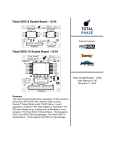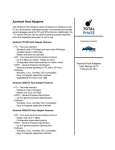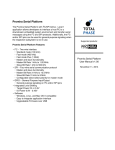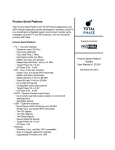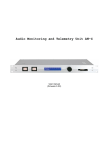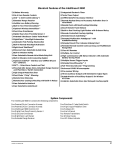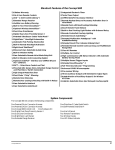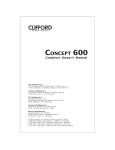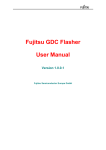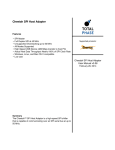Download Control Center Serial User Manual v3.83
Transcript
Control Center Serial
Supported products:
Control Center Serial
User Manual v3.83
November 20, 2015
Summary
The Control Center Serial is a graphical application for use with the
Promira Serial Platform with I2C/SPI capabilities, and the Aardvark
I2C/SPI Host Adapter. It provides access to I2C, SPI, and GPIO
functions of the Promira platform and the Aardvark adapter in an
easy-to-use graphical interface. Batch scripting capability has been
added since version 3.00.
Control Center Serial User Manual v3.83
1 Overview
The Control Center Serial software interacts directly with the Promira platform or
Aardvark adapter.
The Control Center Serial provides basic access to all the functionality of the Promira
Serial Platform and the Aardvark adapter. It is built upon the Promira API and the
Aardvark API as detailed in the Promira Serial Platform and Aardvark adapter manuals.
1.1 Changes in version 3.83
The Control Center Serial v3.83 supports the Promira FW v1.33 and up.
Bug Fixes
• Fixed the SS lines issue on Multi I/O SPI mode.
1.2 Changes in version 3.82
The Control Center Serial v3.82 supports the Promira FW v1.32 and up.
New Features
• Added more GPIO views for the Promira platform.
Bug Fixes
• Fixed the connectivity issue of the first attempt to connect the Promira platform to
Control Center Serial after the device reset.
1.3 Changes in version 3.81
New Features
• Added multi I/O functions in the batch mode.
1.4 Changes in version 3.80
New Features
• Added support for Promira Multi I/O SPI master.
2
Control Center Serial User Manual v3.83
• Added ability to run batch scripts from command line.
• Added Promira network preferences and license display.
1.5 Changes in version 3.72
New Features
• Added more selections for I2C bitrate.
1.6 Changes in version 3.71
New Features
• Updated UI to add a custom IP address.
1.7 Changes in version 3.70
New Features
• Added support for Promira platform.
1.8 Changes in version 3.56
• Removed I2C Monitor.
New Features
• Added a register read function.
• Added the option to auto connect on launch.
• Added the ability to save user preferences.
• Added the ability to tour the features without an attached Aardvark.
1.9 Changes in version 3.55
Bug Fixes
• Fixed bug with connecting to some Aardvark adapters.
3
Control Center Serial User Manual v3.83
1.10 Changes in version 3.54
New Features
• Added a message when connecting to Aardvark OEM adapters.
1.11 Changes in version 3.53
Bug Fixes
• Fixed an issue with XML i2c_free_bus batch commands causing the GUI to hang.
1.12 Changes in version 3.52
New Features
• XML examples are now included within the GUI package rather than as a
separate package.
4
Control Center Serial User Manual v3.83
2 Getting Started
2.1 Requirements
2.1.1 Overview
The Control Center Serial software is offered as a 32-bit binary and it is compatible with
64-bit operating systems. The following sections describe the requirements to run
Control Center Serial. Be sure the device driver has been installed before plugging in the
Promira platform or the Aardvark adapter. Refer to the Software section of the Promira
platform and Aardvark adapter manuals for additional information regarding the driver
and compatibility.
2.1.2 Windows
The Control Center software is compatible with 32-bit and 64-bit versions of Windows 7,
Windows 8, and Windows 8.1. The software will run on 64-bit systems as a 32-bit
application. Windows XP, Vista, 2000 and legacy 16-bit Windows 95/98/ME operating
systems are not supported.
2.1.3 Linux
The Control Center software has been designed for Red Hat Enterprise Linux 5 with
integrated USB support. Kernel 2.6 is required. Other distributions, including Ubuntu,
Fedora, and SuSE have also been known to work. The software will run on 64-bit
systems as a 32-bit application, provided that 32-bit system libraries are available.
2.1.4 Mac OS X
The Control Center Serial software is compatible with Intel versions of Mac OS X 10.5
Leopard, 10.6 Snow Leopard, 10.7 Lion, 10.8 Mountain Lion, 10.9 Mavericks, and 10.10
Yosemite. Installation of the latest available update is recommended.
2.1.5 Promira platform and Aardvark adapter
Version 3.80 (or greater) of the Control Center Serial software requires a Promira
platform that runs version 1.30 or higher of the firmware.
Version 3.70 (or greater) of the Control Center Serial software supports both Promira
platform (up to firmware 1.20) and Aardvark adapter.
Version 3.50 (or greater) of the Control Center Serial software requires an Aardvark
adapter that runs version 3.40 or greater of the firmware.
5
Control Center Serial User Manual v3.83
Aardvark adapter with version 2.1 or greater of the hardware will be able to use the
target power and configure I2C pullup functionality.
2.2 Installing Control Center Serial
The Control Center Serial software is a self-contained application. Installing the software
is as easy as unarchiving the software package. To install the Control Center Serial:
1. Download the latest version of the software from the Total Phase website.
2. Unzip the zip archive to your desired location.
2.3 Launching the Control Center Serial
2.3.1 Windows
Figure 1 : Control Center Serial Directory – This is what the
directory should look like after the software has been
extracted.
1. Go to the folder where the software package was extracted.
2. Click on "Control Center Serial.exe"
2.3.2 Linux
1. Go to the installation directory where the software package was unzipped.
6
Control Center Serial User Manual v3.83
2. Run >./controlctr
2.3.3 Mac OS X
1. Go to the installation directory where the software package was unzipped.
2. Click on "Control Center Serial.app"
2.3.4 Command Line Options
To launch the Control Center Serial from the command line, use the script located in the
bin directory in the software package. Note that the bin directory is located inside the app
bundle on Mac OS X.
The following option are available when running the Control Center application from the
command line:
• -b FILE, Run the given script that contains the list of commands.
• -c, Create a command line interface.
To view all available commands, type help into the command line. Type help
COMMAND to see help specific to a particular command.
Command Line Mode
The -b FILE option allows for the specified file to be run. The file can contain commands.
The following is an example of the content of FILE:
# line starting with '#' will be regarded as a comment.
# connect the Aardvark connected to port 0.
connect 0
# run lights.xml.
batch ./examples/lights.xml
# disconnect the device.
disconnect 0
Command Line Console
Using the -c option will create a command line console on the command line where the
Control Center Serial was launched.
7
Control Center Serial User Manual v3.83
How To Launch Command Line
Windows
1. Run Command Prompt and go to the installation directory where Control Center
Serial.exe is.
2. Run windows\controlctr.exe OPTIONS.
Linux
1. Run terminal and go to the installation directory where controlctr is.
2. Run controlctr OPTIONS.
Mac OS X
1. Run terminal and go to the installation directory where Control Center Serial.app
is.
2. Run "Control Center Serial.app/Contents/MacOS/Control Center Serial"
OPTIONS.
2.4 Operating the Control Center Serial
Promira platform or Aardvark adapter must be configured for use before the Control
Center Serial software can be used to send and receive any messages. To configure
Promira platform or Aardvark adapter, go to the menu item: Adapter | Connect.
8
Control Center Serial User Manual v3.83
2.4.1 Configure the Adapter
Figure 2 : Configure Adapter Window – The Configure
Adapter window is organized in two major sections: the list
of available Promira platforms and Aardvark adapters and
the list of operational modes.
The configuration window (figure 2 ) is organized into two sections: the list of available
Promira platforms and Aardvark adapters and a list of operational modes.
List of Available Adapters
In the configure window, there is a list of all the available Promira platforms and
Aardvark adapters that are connected to the computer. If no Promira platforms or
Aardvark adapters appear in the list, then there are no available units connected to your
computer.
Refresh List
To see an updated list of Promira platforms and Aardvark adapters attached to the
computer, simply click on the "Refresh List" button to rescan the USB / Ethernet bus.
Please note that Promira adapters and Aardvark adapters that are in use by other
applications are no longer available and consequently do not appear in the list of
available units.
9
Control Center Serial User Manual v3.83
The list of Promira platforms and Aardvark adapters provides the following information:
Port
The port that the Promira platform or Aardvark adapter occupies. The Aardvark port
number is a zero based number.
For more information about USB port assignments for Aardvark adapter, please
consulting section 3.5: USB Port Assignment of the Aardvark adapter manual.
For the Promira platform, the port number is listed as the IP address of the device. A
device may have two ports if both the Ethernet and USB ports are connected.
Hardware Version (HW Ver.) & Firmware Version (FW Ver.)
For more information about version numbers, please consult the Promira Serial Platform
manual, Section 3.4 Dynamically Linked Library - DLL Versioning and Section 3.5
Rosetta Language Bindings - API Integration into Custom Applications - Versioning and
Aardvark I2C/SPI Host Adapter manual, Section 3.6 Aardvark Dynamically Linked Library
- DLL Versioning and Section 3.7 Rosetta Language Bindings - API Integration into
Custom Applications - Versioning .
For Promira Serial Platform, two FW version numbers are shown. The first one is the
version number of FW management and the second one is the version number of FW
application.
Serial Number
The serial number of the Promira platform or Aardvark adapter.
I2C, SPI, and GPIO
Supported modules. "Yes" indicates that a module is supported. "No" indicates that a
module is not supported.
2.4.2 Operational Modes
On the right side of the window is a list of the five operational modes: "I2C + SPI", "I2C +
GPIO", "SPI + GPIO", "GPIO Only", and "Batch Mode". Select the radio button next to
the desired mode.
The mode of the Promira platform or Aardvark adapter can be changed after the unit has
already been connected. For additional information see Section 2.5 Reconfiguring the
Promira platform and Aardvark adapter. .
Once you have selected the Promira platform or Aardvark adapter and the desired
mode, click on "OK"" to continue.
10
Control Center Serial User Manual v3.83
The port and serial number of the Promira platform or Aardvark adapter will appear in
the status bar at the bottom of the window to indicate which Promira platform or
Aardvark adapter is bound to this instance of the application.
2.4.3 Add custom IP addresses
The Promira platform communicates through the Ethernet protocol and can be
accessible from anywhere. However, the Control Center Serial scans for devices directly
connected to the PC. To allow Control Center to find a device that is not directly
connected, the user can specify a custom IP address to search for.
More than one IP address can be specified. Each IP address should be separated by a
comma(',') or a space. This information is saved in the preference file.
2.5 Reconfiguring the Promira platform and Aardvark
adapter
After the Control Center Serial has been configured with a specific Promira platform or
Aardvark adapter, it is possible to change the Promira platform or Aardvark adapter and/
or the mode that it is operating in.
2.5.1 Change Mode
To change the mode but continue using the same Promira platform or Aardvark adapter
go to the menu item:
Adapter
Select the desired mode and the Control Center Serial will be automatically reconfigured
to reflect this selection.
2.6 Powering Downstream Devices
It is possible to power a downstream target, such as an I2C/SPI EEPROM/flash with the
Promira platform or Aardvark adapters power (which is provided by the USB port or
external power supply). More information about powering downstream devices can be
found in the Promira platform and Aardvark adapter manuals.
NC / 3.3V / 5V (Pin 4) : Target Power (Aardvark and Promira)
NC / 3.3V / 5V (Pin 6) : Target Power (Aardvark and Promira)
NC / 0.9V-3.3V (Pin 22): I/O Power (Promira only)
NC / 0.9V-3.3V (Pin 24): I/O Power (Promira only)
11
Control Center Serial User Manual v3.83
By default, these pins are left unconnected at the time of shipping. For Promira platforms
or Aardvark adapters with hardware versions 2.00 and greater, these pins can be
enabled through the Control Center Serial software. Simply go to the menu item:
Adapter | Target Power (Pin 4, 6) or Adapter | IO Power (Pin 22, 24).
A checkmark indicates that power will be supplied to downstream devices on both pins.
2.7 Shifting Logical Level
The Promira platform is capable of shifting the I2C/SPI signals logical level and the IO
power signals (pins 22 and 24) level from 0.9 V to 3.3 V. Available options are 0.9 V, 1.0
V, 1.2 V, 1.5 V, 1.8 V, 2.5 V, 3.0 V, 3.3 V. To do so, go to the menu item:
Adapter | Level Shift.
2.8 Configuring Network Preferences
The Promira platform is connected through Ethernet or Ethernet over USB. The network
preferences for Ethernet is configurable. To do so, go to the menu item:
Adapter | Network Preference.
2.8.1 Query or Configure Network Preferences
Figure 3 : Network Preferences Window – The Network
Preferences window is to query or to configure the network
preferences of the currently connected Promira platform.
12
Control Center Serial User Manual v3.83
The default network preferences of the Promira platform for Ethernet is a static and its IP
address is 192.168.11.1 and only the network preferences for Ethernet is configurable.
Static IP Addressing
To configure to static IP addressing, select Manually and select Apply.
To change the IP address or the Subnet Mask, type a new value and select Apply.
Dynamic IP Addressing
Figure 4 : Network Preferences Window (DHCP)– When
DHCP is enabled, IP address and Subnet Mask is readonly, to refresh the preferences, select Refresh.
To configure to dynamic IP addressing, select Using DHCP and select Apply.
Once it is configured to dynamic IP addressing, it takes seconds for a router to allocate
an IP address of the Promira platform.
DHCP Renew is to release the currently allocated IP address and is to get new IP
address.
Notes
If new settings are for the current connection, user will see the following warning.
13
Control Center Serial User Manual v3.83
Figure 5 : Network Preferences Warning Window.
2.9 Printing License
The Promira platform has a license file. To print the license file on screen, go to the
menu item: Adapter | Print License.
2.10 Disconnecting the Adapter
The Promira platform or Aardvark adapter can be disconnected from the current
application. To do so, go to the menu item: Adapter | Disconnect.
When disconnected, the application will return to the starting screen.
2.11 Auto Connect the Adapter
The Auto Connect option allows single-adapter users to conveniently bypass the device
connection during Control Center Serial launch. When this option is enabled and one
adapter is attached to the system, Control Center Serial will automatically connect to the
adapter on launch. To do so, go to the menu item: Adapter | Auto Connect
Note: Auto connect may fail if the device is in use by another application or is otherwise
not connectable. In this case, a warning will appear alerting the user of the connection
failure.
2.12 Exiting the Application
To exit the application, go to the menu item: File | Exit Application.
14
Control Center Serial User Manual v3.83
3 Application
3.1 General
The main application window is divided into two sections. The top section contains the
modules for use with the adapter. Depending on the device and selected mode, different
modules will appear in the main display. The available modules are I2C, SPI, Multi I/O
SPI, and GPIO. Each one has different features and functionality which are explained in
Section 4 Modules.
The bottom section of the application contains the Transaction Log. The log keeps track
of all transactions that the adapter sends or receives.
3.2 Transaction Log
3.2.1 Elements of the Transaction Log
Figure 6 : The Transaction Log – The Transaction Log
records all transactions that are performed by the adapter.
This log can be saved as a file for future reference.
The Transaction log is a scrolling list of all the transactions that the adapter sends or
receives. The information is arranged in the following columns.
Time
Time of the transaction. This information is displayed in the format:
15
Control Center Serial User Manual v3.83
YYYY-MM-DD hh:mm:ss.xxx
Module (Mod.)
The module that logged the transaction. This can be either I2C, SPI, or GPIO. Log
entries from for different modules have different background colors to make them easier
to identify.
Table 1 : Transaction Background Colors
I2C
White
SPI
Yellow
GPIO Gray
Read/Write (R/W)
This column is only used by I2C and SPI
Whether the transaction was a read transaction ("R") or a write transaction ("W") or a
register read transaction ("RegW" or "RegR").
Master/Slave (M/S)
This column is only used by I2C and SPI
Indicates the mode that the attached adapter is functioning in. If the adapter is operating
as a master, then an "M" appears. In the adapter is operating as a slave, then an, "S"
appears.
Features (Feat.)
This column is only used by I2C and SPI
This is a string that indicates the features that were active during the transaction.
I2C
I2C features are encoded in the string: TCS
T - 10-bit Addressing
C - Combined FMT
S - No Stop
16
Control Center Serial User Manual v3.83
If the feature is not being used, then a "-" appears in place of the character. More
information about the specific features can be found in Section 4.1 I2C .
For example, in a transaction that uses 10-bit addressing and the no stop feature, the
feature string would be "T-S".
SPI
SPI data exchange parameters are string encoded. The order of the parameters is:
Polarity ("R" or "F")
Rising ("R") or Falling ("F")
Phase ("S" or "s")
Sample/Setup ("S") or Setup/Sample ("s")
Bit Order ("M" or "L")
Most Significant Bit First - MSB ("M )
Least Significant Bit First - LSB ("L")
SS Polarity ("L" or "H")
SS Active Low ("L")
SS Active High ("H")
If a feature is not being used, then a "-" appears in the place of the character. More
information about the SPI Bit Protocol can be found in Section 4.2 SPI
For example, in a transaction that uses Falling polarity, Setup/Sample Phase and Most
Significant Bit First, the feature string would be: "FsM-"
Bitrate (B.R.)
This column is only used by I2C and SPI
Indicates the speed of the transaction in kbps. The value logged in this column many
differ from the bitrate specified. The value reported here is the actual bit rate returned by
the adapter.
Address (Addr.)
This column is only used by I2C
The address that was the target of the transaction.
17
Control Center Serial User Manual v3.83
In the case of I2C master, the address is the slave address that the master targeted for
communication.
In the case of I2C slave, the address will be the address of the adapter unless the
adapter slave is answering a general call in which case 0x80 will appear in the address
column.
Length (Len.)
This column is only used by I2C and SPI
The number of bytes in the transaction. In the case where bytes are dropped from the
transmission, DB will appear in this column to indicate that the message was truncated
and bytes were dropped from the end of the message.
Data
I2C and SPI
The message in hexadecimal.
GPIO
The GPIO values in the log is the OR-ed values of the pins involved. The pins have the
following values:
Signal
SCL
=
SDA
=
MISO =
SCK
=
MOSI =
SS
=
Aardvark
0x01
0x02
0x04
0x08
0x10
0x20
Promira
0x01
0x02
N/A
N/A
N/A
0x04
Set
The data is in the format:
OUT:0xXX DIRECTION:0xXX PULLUPS:0xXX
Get
The data is in the format:
18
Control Center Serial User Manual v3.83
IN:0xXX DIRECTION:0xXX PULLUPS:0xXX
OUT and IN
A value of 1 indicates that the pin has been set logic high and 0 indicated logic low. For
example, if SCL, MOSI and SS where set to logic high, then the value of OUT would be:
0x31.
0x01 | 0x10 | 0x20 = 0x31
DIRECTION
A value of 1 indicates that the direction is out and 0 indicates that the direction is in. For
example, if SDA, MISO and SS were set to output and the rest of the pins to input, the
value of DIRECTION would be: 0x26.
0x02 | 0x04 | 0x20 = 0x26
PULLUPS
A value of 1 indicates that the pullup is on and 0 indicates the pullup is off. For example,
if MISO, SCK, MOSI and SS had their pullups turned on, the value of PULLUP would be:
0x3c.
0x04 | 0x08 | 0x10 | 0x20 = 0x3c
More information about GPIO can be found in Section 4.3 GPIO.
19
Control Center Serial User Manual v3.83
3.2.2 Transaction Viewer
Figure 7 : The Transaction Viewer
The transaction viewer is a convenient way to view the full details of a transaction. To
see an transaction in the Transaction Viewer, double-click on an entry in the transaction
log.
Save Data
The transaction data can be saved in a binary file. Click on the "Save Data" button to
bring up the save file dialog. This binary file can later be loaded as a message in I2C or
SPI.
3.2.3 Clear Log
Deletes all entries from the Transaction Log.
Note that all transactions are cleared immediately when the button is pressed.
20
Control Center Serial User Manual v3.83
3.2.4 Save To File
The data in the log can be exported in a comma separated values (CSV) format by
clicking on the "Save To File" button. You will be prompted for a filename to save the
data.
The log file has a header with the following information:
Export Time: [time of export]
Port [port number]
Adapter HW_Version: [hw version]
FW_Version: [fw version]
After the header, all transactions are appended, one per line. The column order in the
exported file is the same as the order columns in the transaction log.
21
Control Center Serial User Manual v3.83
4 Modules
4.1 I2C
Inter-IC bus, or I2C, was developed by Philips in the 1980s. I2C is a low-bandwidth, short
distance protocol for on board communications. All devices are connected through two
wires: serial data (SDA) and serial clock (SCL).
The Control Center Serial I2C module consists of 2 tabs, master and slave.
4.1.1 I2C Pull-ups
The Promira platform and Aardvark adapter have optional pull up resistors on theI2C
signals (SCL and SDA). For more information about the pull-up resistors, please consult
the Promira platform and Aardvark adapter manuals.
Promira platforms and Aardvark adapters with a hardware versions 2.00 and greater
have the ability to enable the pull-up resistors through the Control Center Serial
application. To toggle the pull-up resistors, go to the menu item:
Adapter -> I2C Pull-ups
A checkmark indicates that the pull-up resistors have been enabled on the I2C lines.
22
Control Center Serial User Manual v3.83
4.1.2 I2C Master
Figure 8 : I2C Master tab of the I2C Module
As a master device, there are three actions, write, read, or register read. For these
actions, there are a number of parameters that can or must be specified: bitrate, slave
address, and other I2C features.
Bitrate
The bitrate is the speed of communications between the master and the slave. The
maximum master I2C bitrate is 1.0 MHz and the minimum is 1 kHz. Control Center Serial
supports many intermediate bit rates between these values. More information about the
bit rate can be found in the Promira platform and Aardvark adapter manuals.
Changing the Bitrate
To change the bitrate, simply select a bitrate from the pull-down menu or alternatively,
enter your own bitrate and press <Enter>.
23
Control Center Serial User Manual v3.83
Figure 9 : Bitrate Confirmation Dialog
If the bitrate you entered is not available, the application will display a message
indicating the close matching bitrate. Click on "Yes "to accept this alternative bit rate, or
click on "No" to continue using the existing bitrate.
Slave Address
The slave address is the address of the target I2C slave device. This address can be
entered in either decimal or hexadecimal notation. If using hexadecimal notation, preface
the number with "0x". For 7-bit and 10-bit addressing, the 7 and 10 least significant bits
should be used to specify the address, respectively.
Features
The Promira platform and the Aardvark adapter supports many of the additional I2C
features.
10-Bit Slave Address (10-Bit Addr.)
When 10-bit slave address is selected, the slave address will be treated as a 10-bit
address. The appropriate actions as described in the I2C specification will be performed
to address the 10-bit slave on the bus.
Note: The Promira adapter and Aardvark adapter slave is always a 7-bit addressed
device.
Combined Format (Combined FMT)
When Combined Format is selected, the "combined" format will be used for
Master Read commands. This feature is only enabled when 10-bit addressing is active
because it is only useful when used in conjunction with 10-bit slave Addressing
This flag indicates to the adapter that the address is a 10-bit address but that it is not
necessary to send the entire address using a master write before executing the read.
24
Control Center Serial User Manual v3.83
For specific information about the "combined" format, consult Section 14.2 "Formats with
10-bit address" in the Philips I2C Specification. A link to the specification can be found on
the Total Phase website.
No Stop (No Stop)
When No Stop is selected, the master device will explicitly not signal the stop command
after the last byte in a transaction. The bus will be held and the subsequent master read
or master write events will issue the repeated start on the bus.
Free Bus
The "Free Bus" button will explicitly issue the stop command on the I2C bus.
If the adapter I2C subsystem had executed a master transaction and is holding the bus
due to a previous "No Stop" transaction, the Free Bus command will issue the stop
command and free the bus.
I2C Master Write
Message to Send
Enter the message to be sent in hexadecimal in this field. Spaces will be automatically
added for better legibility but these spaces will not be sent as part of the message. The
maximum message size is 64k (65535) bytes when using 7-bit addressing and 64k-1
(65534) bytes when using 10-bit addressing.
The message can be loaded from a binary file by clicking on the "Load". Conversely,
the message can also be saved to a binary file by clicking on the "Save" button.
Once a message has been set, click on the "Master Write" button to initiate the action.
The results of the action will appear in the transaction log.
I2C Master Read
Number of Data Bytes
This value is the maximum number of bytes the master will accept in a single
transaction. The master may receive fewer bytes than are specified in this field, but not
more. In the case that a slave does not have the requested number of bytes available,
25
Control Center Serial User Manual v3.83
the remainder of the bytes will simply default to 0xff due to the pullup resistors on the
bus.
I2C Master Register Read
The typical protocol to read a register on an I2C device is to perform an I2C write with
the register address followed by a repeated start and an I2C read. The Master Register
Read feature provides a way to do this in one operation. Please consult the datasheet of
your I2C slave device to ensure it follows this protocol.
Register Address
This register address can be entered in either decimal or hexadecimal notation. If using
hexadecimal notation, preface the number with "0x". Note that this is different from the I2
C slave address.
Address Width
The Address Width specifies the size in bytes of the register address. If the provided
Register Address exceeds this width, the least significant bytes of the Register Address
are used.
Number of Data Bytes
This value is the number of bytes the adapter will attempt to read from the I2C slave. The
adapter may receive fewer bytes than are specified in this field, but not more. In the case
26
Control Center Serial User Manual v3.83
that a slave does not have the requested number of bytes available, the remainder of the
bytes will simply default to 0xff due to the pullup resistors on the bus.
4.1.3 I2C Slave
Figure 10 : I2C Slave tab of the I2C Module
Slave Enable
An I2C slave can send messages to and receive messages from a master device after
the master has initiated a transaction. An adapter will not respond as an I2C slave device
unless it has been enabled as a slave device.
When enabling an adapter as a slave device, three parameters must be provided: the
"Slave Address", the maximum number of bytes to send ("Max Tx Bytes") and the
maximum number of bytes to receive ("Max Rx Bytes").
Slave Address
This is the I2C address that adapter will use as an I2C slave device. The adapter always
uses a 7-bit slave address. The address is specified in the 7 least significant bits. The
most significant bit is ignored.
27
Control Center Serial User Manual v3.83
Max Tx Bytes & Max Rx Bytes
The Max Tx Bytes and Max Rx Bytes indicates the maximum number of bytes the
adapter device will send and receive respectively. The adapter will not exceed the
maximum number of bytes that have been specified.
An exception to this rule is "0" which indicates that the number of bytes is unlimited.
Slave Response
A slave response message can be set in the adapter as a response to a write request.
The message entry field operates in the same manner as the I2C master message to
send field. The maximum message size for the Aardvark adapter is 64 bytes and the one
for the Promira Serial Platform is 255 bytes.
The message can be loaded from a binary file by clicking on the "Load" button.
Conversely, the message can also be saved to a binary file by clicking on the "Save"
button.
If more bytes are requested in a transaction than have been specified in the slave
response, the response string will be wrapped as many times as necessary to complete
the transaction. For example if the slave response has been set to:
00 01 02 03 04
and 12 bytes have been requested, the response that is sent to the master will be:
00 01 02 03 04 00 01 02 03 04 00 01
To set the response in the slave, click on the "Set Resp" button. It is advisable to set the
slave response before enabling the slave. If a response is not set before the slave is
enabled, it is possible that a slave response be requested before the slave device has
one to return.
Note: Slave Message Can Be Overwritten
All I2C messages share memory in the adapter. Therefore it is possible that the slave
response may be overwritten in the Aardvark unit.
For example, an I2C slave response is set and then the adapter is enabled as an I2C
slave, but then without disabling the slave, an I2C master transaction is executed. The
adapter will implicitly deactivate the I2C slave and because of the shared memory in the
adapter the I2C master operation will almost always overwrite the I2C slave response.
28
Control Center Serial User Manual v3.83
The safest course of action is to set the slave response each time before enabling or reenabling the I2C slave.
Enabling the Slave
To enable the adapter as an I2C slave, simply click on the "Enable" button.
Figure 11 : Enabled I2C Slave tab of the I2C Module
Once the slave is enabled, the status indicator at the top of the panel will change from
"Disabled" in red to "Enabled" in green.
As request arrive for the slave, the transaction log will be updated with the read and write
actions that the slave performed.
Disabling the Slave
To disable the adapter as an I2C slave device, simply click on the "Disable" button.
Once disabled the status indicator at the top of the panel will change from "Enabled" in
Green to "Disabled" in Red.
29
Control Center Serial User Manual v3.83
Implicit Slave Disabling
Executing an I2C master write or I2C master read will implicitly disable the device as an I2
C slave device. After a master write or read event, it is recommended that the I2C slave
response be resent to the adapter and then it can be re-enabled as an I2C slave device.
Switching the I2C pins to GPIO will also implicitly disable the I2C slave.
4.2 SPI
SPI is a serial communication bus developed by Motorola. It is a full-duplex protocol
which functions on a master-slave paradigm that is ideally suited to data streaming
applications.
The SPI tab consists of two tabs: master and slave.
4.2.1 SPI Data Exchange Parameters
The SPI master and slave need to agree about the data frame for the transaction. The
data frame is described by three parameters: clock polarity, clock phase and bit order.
Figure 12 : SPI Parameters in the SPI Module
These parameters must be the same for both the master and slave modes. More
information about these parameters can be found in the Promira platform and the
Aardvark adapter manuals.
Bitrate
The bitrate is the speed of communications between the master and the slave. The
Control Center Serial supports SPI master from 31 KHz to 40 MHz and SPI slave from
30
Control Center Serial User Manual v3.83
31 KHz to 20 MHz depending on the device. More information about the bit rate can be
found in the Promira platform and Aardvark adapter manuals.
Changing the Bitrate
To change the bitrate, simply select a bitrate from the pull-down menu or alternatively,
enter your own bitrate and press <Enter>.
Figure 13 : Bitrate Confirmation Dialog
If the bitrate you entered is not available, the application will display a message
indicating the close matching bitrate. Click on "Yes" to accept this alternative bit rate or
click on "No" to continue using the existing bitrate.
4.2.2 SPI Master
31
Control Center Serial User Manual v3.83
Figure 14 : SPI Master tab in the SPI Module
The SPI master has an additional parameter that can be set, the polarity of the SS line.
SS Polarity
The SS Polarity indicates whether the adapter will pull the SS pin high or low to activate
the SPI slave device.
Note: When configured as an SPI slave, the adapter will always be setup with SS as
active low.
MOSI Message
MOSI (Master Out, Slave In) message is entered here in hexadecimal format. Spaces
are automatically inserted for legibility. The maximum message size is 4 KiB due to
operating system buffer limits.
The message can be loaded from a binary file by clicking on the "Load" button.
Conversely, the message can also be saved to a binary file by clicking on the "Save"
button.
SPI is a full duplex protocol. When the MOSI message is sent a MISO message is
received. The transaction log will log MOSI and MISO as two separate transactions that
32
Control Center Serial User Manual v3.83
occur at the same time. The length of the two messages will be the same due to the
duplex nature of the protocol.
4.2.3 SPI Slave
Figure 15 : SPI Slave tab in the SPI Module
MISO Message
The MISO (Master In, Slave Out) message is the message that the adapter will return as
its response to a SPI transaction. Like the MOSI message, this message is entered in
hexadecimal format. Spaces are automatically inserted for legibility, but are not sent in
the transaction. The maximum message size for the Aardvark adapter is 64 bytes and
the one for the Promira Serial Platform is 255 Bytes.
It is advisable to set the MISO message before enabling the slave. If a MISO message is
not set before the slave is enabled, it is possible that the message may be requested
before the slave device has one to return.
The message can be loaded from a binary file by clicking on the "Load" button.
Conversely, the message can also be saved to a binary file by clicking on the "Save"
button.
33
Control Center Serial User Manual v3.83
Note: MISO Message Can Be Overwritten
All SPI messages share memory in the adapter. Therefore it is possible that the MISO
message may be overwritten in the Aardvark unit.
For example, a MISO message is set and then adapter is enabled as an SPI slave, but
then without disabling the slave, an SPI master transaction is executed. The adapter will
implicitly deactivate the SPI slave and because of the shared memory in the adapter the
SPI master operation will almost always overwrite the MISO message.
The safest course of action is to set the MISO message each time before enabling or reenabling the SPI slave.
Slave Enable
An adapter will not respond as an SPI slave device until it has been enabled. It is
advisable that the MISO message be set in the slave device before it is enabled to
ensure valid data to all requests.
Figure 16 : Enabled SPI Slave tab in the SPI Module
Once the slave is enabled, the status indicator at the top of the panel will change from
"Disabled" in red to "Enabled" in green. As requests arrive for the slave, the
transaction log will be updated with the read and write actions that the slave performed.
34
Control Center Serial User Manual v3.83
When the MOSI message is received a MISO message is sent to the master. The
transaction log will log MOSI and MISO as two separate transactions that occur at the
same time.
Implicit Slave Disabling
Executing a SPI master write will implicitly disable the adapter as an SPI slave device.
After a master write event, it is recommended that the MISO message be resent to the
adapter and then it can be re-enabled as an SPI slave device.
Switching the SPI pins to GPIO will also implicitly disable the SPI slave.
4.3 Multi I/O SPI
While standard SPI uses a bidirectional protocol with the MOSI and MISO lines, multi I/O
SPI uses parallel data lines (e.g. IO0 to IO3) in a half-duplex fashion. Dual I/O SPI uses
two data lines and Quad I/O SPI uses four data lines.
The Multi I/O SPI tab is only supported by the Promira platform.
4.3.1 Multi I/O SPI Master
Figure 17 : Multi I/O SPI
SPI Mode
The SPI mode defines the data exchange parameters, phase and polarity.
35
Control Center Serial User Manual v3.83
Bit Order
Whether the data shall be transferred Most Significant Bit first or Least Significant Bit
first.
SS Polarity
The SS Polarity indicates whether the adapter will pull the SS pin high or low to activate
the SPI slave device.
Bitrate
The bitrate is the speed of communications between the master and the slave. The
Control Center Serial supports SPI master from 31 KHz to 40 MHz. More information
about the bit rate can be found in the Promira platform manuals.
Changing the Bitrate
To change the bitrate, simply select a bitrate from the pull-down menu or alternatively,
enter your own bitrate and press <Enter>.
Figure 13 : Bitrate Confirmation Dialog
If the bitrate you entered is not available, the application will display a message
indicating the close matching bitrate. Click on "Yes" to accept this alternative bit rate or
click on "No" to continue using the existing bitrate.
Slave Select
The Promira platform supports up to 8 slave selects. However only some of them may
be configurable based on the capabilities of the attached device.
36
Control Center Serial User Manual v3.83
IO Mode
IO Mode indicates which type of SPI will be used for each phase of the transfer. The first
mode in the parenthesis is the IO mode for Command, the second is IO mode for
Address, and the third is the IO mode for either message to write when sending or
message to read when receiving.
Multi I/O SPI Send
A multi I/O SPI write transfer consists of the Promira platform performing the following:
1. Assert slave select
2. Shift out Command (if provided)
3. Shift out Address (if provided)
4. Shift out Data (if provided)
5. De-assert slave select
The data portion can be loaded from a binary file by clicking on the "Load" button.
Conversely, the data portion can also be saved to a binary file by clicking on the "Save"
button.
Multi I/O SPI Receive
A multi I/O SPI read transfer consists of the Promira platform performing the following:
1. Assert slave select
2. Shift out Command (if provided)
3. Shift out Address (if provided)
4. Shift in data from slave
5. De-assert slave select
For Dual and Quad Data I/O modes, no data is shifted out during the data phase since
the data lines switch to inputs during a read transaction. However, when the Data I/O
37
Control Center Serial User Manual v3.83
mode is set to Single, zeros will be shifted out over the MOSI line as data is clocked in
on the MISO line.
4.4 General Purpose IO
Figure 19 : GPIO Module
General Purpose IO, GPIO, on the Aardvark device allows the users to use the six pins
that are normally used for I2C and SPI and use them to send and receive signals. These
six pins are SCL, SDA, MOSI, SCLK, MISO, and SS. GPIO functionality can be
combined with either I2C or SPI or can be used by itself.
GPIO on the Promira platform allows the users to use six to sixteen pins that include the
pins normally used for I2C to send and receive signals. These pins are defined in the
Promira manual. GPIO functionality can be combined with either I2C or SPI or can be
used by itself.
4.4.1 GPIO Configurations
When GPIO is combined with either I2C or SPI, only the pins of the unused module are
available for GPIO. Therefore when using "I2C + GPIO" only the SPI pins are available
for GPIO and when using "SPI + GPIO", only the I2C pins are available for GPIO on the
Aardvark device. For the Promira platform up to eight GPIO pins are available in Control
Center Serial. Other GPIO pins can be utilized through the product API defined in the
Promira platform manual.
38
Control Center Serial User Manual v3.83
Figure 20 : GPIO module when using I2C + GPIO
Figure 21 : GPIO module when using SPI + GPIO
4.4.2 GPIO Parameters
When GPIO module is selected, only the available pins are displayed in the window.
Each pin is labeled and has parameters that can be set by the user.
39
Control Center Serial User Manual v3.83
GPIO #
The GPIO number of each GPIO signal is displayed in the first row of the GPIO window.
Pin #
The position of the pin in the 10/34-pin socket connector for the Promira platform or in
the 10-pin connector for the Aardvark adapter. Information about the pin arrangement
can be found the Promira platform and the Aardvark adapter manuals and on the Total
Phase website.
Value
Each pin has a different value which can be OR-ed together to produce a single number
that represents the state of all the pins.
The pins have the following values:
Signal
SCL
=
SDA
=
MISO =
SCK
=
MOSI =
SS0
=
SS2
=
SS1
=
SS3
=
SS4
=
SS5
=
Aardvark
0x01
0x02
0x04
0x08
0x10
0x20
N/A
N/A
N/A
N/A
N/A
Promira
0x01
0x02
N/A
N/A
N/A
0x04
0x08
0x10
0x20
0x40
0x80
For example, if SCL, MOSI and SS where set to 1, then the value of all pins would be:
0x01 | 0x10 | 0x20 = 0x31
Direction (Dir.)
The direction of the pin, Input or Output.
If a pin is configured as an input pin, then the pullup selector and In Value row are
enabled and the Out Set and Out Value rows are disabled.
40
Control Center Serial User Manual v3.83
If a pin is configured as an output pin, then the pullup selector and the In Value are
disabled and the Out Set and Out Value rows are disabled.
All In and All Out
The "All In" and "All Out" buttons are convenience buttons to set all pins to input or
output respectively.
Pull Ups (P.U.)
For the Aardvark device indicates whether the pullup is active or inactive on a pin. The
pullup selector is only enabled when the pin is set to the in direction because the pullup
are only turned on on pins that have been configured as input. If a line is configured as
output, the pullup mask is cached and the pullup configuration for that line will only take
effect if the line is later configured as an input.
For the Promira platform only pins 1 and 3 can have pull-ups which are enabled via the
"Adapter" pull down menu.
All On and All Off
The "All On" and "All Off" buttons are convenience buttons to turn on the pullups on or
off respectively on all pins.
Note: Only Aardvark device pins that have been configured to be input will be affected by
these buttons.
Note: I2C Pin Pullups
It is not possible to disable the pullups for SCL and SDA input on Aardvark adapter with
Hardware Version 1.02.
Out Set & Out Value
The "Out Set" boxes are a staging area for setting the levels of the output pins. Only "0"
and "1" are accepted in these text boxes.
The values in the "Out Set" boxes are only applied once the "Set "button is clicked. The
"Out Value" indicates the last known values of the output pins. After clicking the "Set"
button the "Out Set" and the "Out Value" for all pins configured as output should
match. The parameters of the transaction are added to the transaction log.
If a pin is switched from output to input, the values in "Out Set" and "Out Value" are
disabled but are conserved. When a pin is switched back to output, these values will be
restored.
41
Control Center Serial User Manual v3.83
In Value
The "In Value" is the last known values of the input pins. Initially the values for the In
Value will be "X" indicating that the value is not known on the pin.
The "In Value" of the input pins are updated when the "Get" button is clicked. The
parameters of the transaction are added to the transaction log.
The "In Value" for an output pin will always display an "X" because the input value of
this pin is not known.
4.5 Batch Mode
Figure 22 : Batch Scripting Module
In Batch mode, the user can specify an arbitrary set of instructions for the adapter to
execute in sequence. This scripting language is based on XML.
4.5.1 Batch Instructions
A set of batch instructions for an adapter is scripted in an XML based language. A set of
instructions must be contained within a set of <adapter> tags. Each command is
specified by an XML tag. These tags are described in section 5. Batch Instruction
Commands . Commands are executed in the order that they appear in the XML block.
Help for the Batch Commands is available in the Control Center Serial software which
explains all the available commands. Just click on the "Help" button.
42
Control Center Serial User Manual v3.83
Figure 23 : Batch Commands Help System
4.5.2 Editing Batch Instructions
The Batch XML Instructions are entered in this text field. Batch instructions can be saved
and loaded as XML files via the "Save" and "Load" buttons respectively. The "Clear"
button will clear all contents out of the text field. The following dialog box will appear to
confirm that the user wants to clear all data out of the text field.
43
Control Center Serial User Manual v3.83
Figure 24 : When clearing the batch command console, a
dialog box will appear to confirm the user's action.
4.5.3 Executing Batch Instruction
To execute a set of batch instructions, simply click on the "Execute" button. When a
script is executing, the status indicator will turn green. The results from the commands
will appear in the transaction log. While a script is running, it is not possible to edit the
batch instructions.
To stop the execution of a script, simply click on the "Stop" button.
Figure 25 : Executing a batch command script.
Once the script has completed, the status indicator will change back to red and the batch
instructions will once again be editable.
Batch Instruction Error
When the "Execute" button is clicked, the instruction set is parsed and validated. In the
event of an error, a dialog box will open indicating the type of error and the command in
which the error appears.
44
Control Center Serial User Manual v3.83
Figure 26 : Batch command error dialog.
The format of the error message is:
n) command [attribute] - error message
where:
n
zero-based index of the command
command
command type
attribute
attribute name where the error occurred. If an error is not associated
with an attribute, this field will be omitted.
error message
error message.
Click OK to close the dialog.
45
Control Center Serial User Manual v3.83
5 Batch Instruction Commands
5.1 Notes on Batch Instructions
Unless specified otherwise, all arguments to a batch instruction are "1" to enable/request
the specified parameter, or "0" to disable/not request the specified parameter.
The Batch Instruction commands support I2C master, SPI master, and GPIO modes.
However, the batch Instruction commands do not support I2C slave and SPI slave mode.
5.2 General Commands
5.2.1 Configure
<configure i2c="i2c"
spi="spi"
gpio="gpio"
tpower="tpower"
iopower="iopower" (Promira only)
levelshift="levelshift" (Promira only)
pullups="pullups"/>
Activate/Deactivate individual sub-systems and features
Parameters
i2c
Enable I2C
spi
Enable SPI
gpio
Enable GPIO
tpower
Enable Target Power on pins 4 and 6
iopower
Enable Target Power on pins 22 and 24 for the Promira
platform
levelshift
The logic level for all signal pins including Target Power
pins 22 and 24 on the Promira platform.
pullups
Enable pullup resistors on the I2C lines: SCL and SDA.
Details
It is not possible to activate I2C, SPI, and GPIO all at the same time. The possible
combinations are:
Table 2 : Allowed configuration combinations
46
Control Center Serial User Manual v3.83
i2c spi gpio Configuration
"1"
"1"
"0"
I2C and SPI enabled
"1"
"0"
"1"
I2C enabled and SPI pins used as GPIO
"0"
"1"
"1"
SPI enabled and I2C pins used as GPIO
"0"
"0"
"1"
I2C and SPI pins used as GPIO
Please see the Promira platform and the Aardvark adapter manuals for more information
about supplying target power and I2C pullup resistors.
5.2.2 sleep
<sleep ms="ms"/>
Set the Aardvark adapter or the Promira Serial Platform to sleep for a number of
milliseconds.
Parameters
ms
Requested number of milliseconds to sleep.
5.3 I2C Commands
5.3.1 i2c_bitrate
<i2c_bitrate khz="khz"/>
Set the I2C bitrate in kilohertz.
Parameters
khz
requested bitrate in kHz
Details
The default power-on bitrate is 100khz.
Only certain discrete bitrates are supported by the I2C master interface. The actual
bitrate set will be less than or equal to the requested bitrate and is returned in the
Transaction Log.
Please see the Promira platform and the Aardvark adapter manuals for more
information.
47
Control Center Serial User Manual v3.83
5.3.2 i2c_write
<i2c_write addr="addr"
count="count"
nostop="nostop"
ten_bit_addr="ten_bit_addr"
combined_fmt="combined_fmt"
radix="radix">
message
</i2c_write>
Write a stream of bytes to the I2C slave device.
Parameters
addr
The slave from which to read. The slave address can
be specified in decimal or hexadecimal notation.
count
The number of bytes to write (maximum 65535).
nostop
Request that no stop condition is issued on the I2C bus
after the transaction completes.
ten_bit_addr
Request that the provided address is treated as a 10-bit
address.
combined_fmt
Request that the Philips combined format is followed
during a I2C write operation. This only has an effect
when used in conjunction with 10-bit addressing.
radix
The base of the number system of the message, with
the value being 10 for decimal, or 16 for hexadecimal.
message
The message to transmit as a space-separated list of
numbers.
Details
The default power-on bitrate is 100khz.
Only certain discrete bitrates are supported by the I2C master interface. The actual
bitrate set will be less than or equal to the requested bitrate and is returned in the
Transaction Log.
48
Control Center Serial User Manual v3.83
Please see the Promira platform and the Aardvark adapter manuals for more
information.
5.3.3 i2c_read
<i2c_read addr="addr"
count="count"
nostop="nostop"
ten_bit_addr="ten_bit_addr"
combined_fmt="combined_fmt"/>
Read a stream of bytes from the I2C slave device.
Parameters
addr
The slave from which to read. The slave address can
be specified in decimal or hexadecimal.
count
The number of bytes to read (maximum 65535).
nostop
Request that no stop condition is issued on the I2C bus
after the transaction completes.
ten_bit_addr
Request that the provided address is treated as a 10-bit
address.
combined_fmt
Request that the Philips combined format is followed
during a I2C read operation. This only has an effect
when used in conjunction with 10-bit addressing.
Details
For ordinary 7-bit addressing, the lower 7 bits of the addr should correspond to the
slave address. The topmost bits are ignored. The adapter I2C subsystem will
assemble the address along with the R/W bit after grabbing the bus. For 10-bit
addressing, the lower 10 bits of addr should correspond to the slave address. The
adapter will then assemble the address into the proper format as described in the
Philips specification, namely by first issuing an write transaction on the bus to
specify the 10-bit slave and then a read transaction to read the requested number of
49
Control Center Serial User Manual v3.83
bytes. The initial write transaction can be skipped if the Combined Format feature is
requested in conjunction with the 10-bit addressing functionality.
Please see the Promira platform and the Aardvark adapter manuals for more
information.
5.3.4 i2c_free_bus
<i2c_free_bus/>
Free the adapter I2C subsystem from a held bus condition (e.g., no stop).
Parameters
None
Details
If the adapter I2C subsystem had executed a master transaction and is holding the
bus due to a previous nostop flag, this function will issue the stop command and
free the bus.
Please see the Promira platform and the Aardvark adapter manuals for more
information.
5.4 SPI Commands
5.4.1 spi_config
<spi_config polarity="polarity"
phase="phase"
bitorder="bitorder"
ss="ss"/>
Configure the SPI master interface.
Parameters
polarity
Set as either "rising/falling" or "falling/rising".
phase
Set as either "sample/setup" or "setup/sample".
bitorder
Set as either "msb" or "lsb".
ss
Set as either "active_low" or "active_high".
Details
50
Control Center Serial User Manual v3.83
These configuration parameters specify how to clock the bits that are sent and
received on the adapter SPI interface.
The polarity option specifies which transition constitutes the leading edge and which
transition is the falling edge. For example, rising/falling would configure the SPI to
idle the SCLK clock line low. The clock would then transition low-to-high on the
leading edge and high-to-low on the trailing edge.
The phase option determines whether to sample or setup on the leading edge. For
example, "sample/setup" would configure the SPI to sample on the leading edge
and setup on the trailing edge. The bitorder option is used to indicate whether LSB
or MSB is shifted first.
The ss option is used change the output polarity on the SS line. For example,
"active_low" will pull the SS line low to active the slave device.
Please see the Promira platform and the Aardvark adapter manuals for more
information.
5.4.2 spi_bitrate
<spi_bitrate khz="khz"/>
Set the SPI bitrate in kilohertz.
Parameters
khz
requested bitrate in kHz.
Details
The power-on default bitrate is 1000 kHz. Only certain discrete bitrates are
supported by the Promira platform and the Aardvark adapter. As such, this actual
bitrate set will be less than or equal to the requested bitrate unless the requested
value is less than 31 kHz, in which case the Promira platform will default the bitrate
to 31 kHz. The actual bitrate set is returned in the Transaction Log.
Please see the Promira platform and the Aardvark adapter manuals for more
information.
51
Control Center Serial User Manual v3.83
5.4.3 spi_write
<spi_write io="io"
count="count"
radix="radix">
message
</spi_write>
Write a stream of bytes to the downstream SPI slave device and read back the fullduplex response.
Parameters
io
SPI IO mode to write a stream of bytes, with the value 0 for
standard SPI, 2 for dual, or 4 for quad.
count
The number of bytes to write (maximum 65535).
radix
The base of the number system of the message, with the
value being 10 for decimal or 16 for hexadecimal.
message
The message to transmit as a space separated list of
numbers.
Details
If count is 0, no bytes will be written to the slave. However, the slave select line will
be dropped for 5-10 microseconds. This can be useful in sending a signal to a
downstream SPI slave without actually sending any bytes. For example, if an SPI
slave has tied the slave select to an interrupt line and it sees the line is toggled
without any bytes sent, it can interpret the action as a command to prepare its
firmware for an subsequent reception of bytes.
Please see the Promira platform and the Aardvark adapter manuals for more
information.
5.4.4 spi_read
<spi_read io="io"
count="count"/>
Read a stream of bytes from the downstream SPI slave device when IO mode is either
dual or quad. However, when IO mode is standard, it writes 00's and reads a stream of
bytes.
52
Control Center Serial User Manual v3.83
Parameters
io
SPI IO mode to write a stream of bytes, with the value 0 for
standard SPI, 2 for dual, or 4 for quad.
count
The number of bytes to write (maximum 65535).
Details
Please see the Promira platform and the Aardvark adapter manuals for more
information.
5.5 GPIO Commands
The following table maps the named lines on the I2C/SPI output cable to bit positions in
the direction and pullups masks. All GPIO API functions will index these lines through a
single 8-bit masked value. Thus, each bit position in the mask can be referred back its
corresponding line through the mapping described below.
Table 3 : GPIO Bit Values
Pin # Aardvark Bit Value Promira Bit Value Description
Pin 1
0x01
0x01
I2C SCL line
Pin 3
0x02
0x02
I2C SDA line
Pin 5
0x04
N/A
SPI MISO line
Pin 7
0x08
N/A
SPI SCK line
Pin 8
0x10
N/A
SPI MOSI line
Pin 9
0x20
0x04
SPI SS line
5.5.1 gpio_config
<gpio_config direction="direction"
pullups="pullups"/>
Configure the GPIO interface.
Parameters
direction
A single byte value where each bit corresponds to the
physical line as defined in Table 3. If a line's bit is 0, the line
is configured as an input. Otherwise it will be an output.
53
Control Center Serial User Manual v3.83
pullups
A single byte value where each bit corresponds to the
physical line as defined in Table 3. If a line's bit is 1, the lines
pullup is active whenever the line is configured as an input.
Otherwise the pullup will be deactivated.
Details
Please see the Promira platform and Aardvark adapter manuals for more
information.
5.5.2 gpio_get
<gpio_get/>
Get the value of current GPIO inputs.
Parameters
None
Details
A line's bit position in the mask will be 0 if it is configured as an output or if it
corresponds to a subsystem that is still active.
Please see the Promira platform and the Aardvark adapter manuals for more
information.
5.5.3 gpio_set
<gpio_set value="value"/>
Set the value of current GPIO outputs.
Parameters
value
A bitmask as defined in Table 3 specifying which outputs should
be set to logic high and which should be set to logic low.
Details
If a line is configured as an input or not activated for GPIO, the output value will be
cached. The next time the line is an output and activated for GPIO, the output value
previously set will automatically take effect.
54
Control Center Serial User Manual v3.83
Please see the Promira platform and the Aardvark adapter manuals for more
information.
55
Control Center Serial User Manual v3.83
6 Notes
6.1 Multiple Units
It is possible to operate multiple adapters simultaneously. Each window of the
application is bound to a single adapter. Additional adapters can be accessed by
opening additional windows.
To open a new Window simply go to the menu item: File | New Window.
A new window will open which will need to be configured to the additional adapter.
6.2 Promira platform and Aardvark adapter Technical
Specifications
Detailed information about the Technical Specifications of the Promira platform and the
Aardvark adapter can be found on the Total Phase website: http://www.totalphase.com/
56
Control Center Serial User Manual v3.83
7 Firmware
7.1 Field Upgrades
7.1.1 Upgrade Philosophy
The Promira platform is designed so that its internal license and firmware can be
upgraded in the field by the user.
7.1.2 Upgrade Procedure
1. Download the license/firmware upgrade package to your PC.
2. Launch the Control Center Serial software and connect to the device (Adapter |
Connect).
3. Go to Adapter | Upgrade License/Firmware. The software notifies you before
proceeding.
Figure 27 : Initialize Device command warning
dialog.
4. Select OK. The Control Center Serial software initializes and reboots the device
for firmware upgrade. This can take up to 15 seconds.
5. Upon reboot, the device will appear as a hard drive on the PC. Note: If Windows
prompts to scan and fix the hard drive, go ahead and let it scan and fix the hard
drive.
57
Control Center Serial User Manual v3.83
Figure 28 : Device appears as hard drive on PC.
6. Unzip the firmware upgrade package and copy .pmu file to the hard drive of the
device.
7. Important: Make sure to safely eject the hard drive from the PC after the
copy.
8. Power-cycle the device again by disconnecting and re-connecting the USB cable.
It will take a few seconds for the device to complete the update. Also, restart the
Control Center Serial software after the firmware upgrade.
58
Control Center Serial User Manual v3.83
8 Legal / Contact
8.1 Disclaimer
All of the software and documentation provided in this manual, is copyright Total Phase,
Inc. ("Total Phase"). License is granted to the user to freely use and distribute the
software and documentation in complete and unaltered form, provided that the purpose
is to use or evaluate Total Phase products. Distribution rights do not include public
posting or mirroring on Internet websites. Only a link to the Total Phase download area
can be provided on such public websites.
Total Phase shall in no event be liable to any party for direct, indirect, special, general,
incidental, or consequential damages arising from the use of its site, the software or
documentation downloaded from its site, or any derivative works thereof, even if Total
Phase or distributors have been advised of the possibility of such damage. The software,
its documentation, and any derivative works is provided on an "as-is" basis, and thus
comes with absolutely no warranty, either express or implied. This disclaimer includes,
but is not limited to, implied warranties of merchantability, fitness for any particular
purpose, and non-infringement. Total Phase and distributors have no obligation to
provide maintenance, support, or updates.
Information in this document is subject to change without notice and should not be
construed as a commitment by Total Phase. While the information contained herein is
believed to be accurate, Total Phase assumes no responsibility for any errors and/or
omissions that may appear in this document.
8.2 Life Support Equipment Policy
Total Phase products are not authorized for use in life support devices or systems. Life
support devices or systems include, but are not limited to, surgical implants, medical
systems, and other safety-critical systems in which failure of a Total Phase product could
cause personal injury or loss of life. Should a Total Phase product be used in such an
unauthorized manner, Buyer agrees to indemnify and hold harmless Total Phase, its
officers, employees, affiliates, and distributors from any and all claims arising from such
use, even if such claim alleges that Total Phase was negligent in the design or
manufacture of its product.
8.3 Contact Information
Total Phase can be found at http://www.totalphase.com/. If you have support-related
questions, please submit a support request at http://www.totalphase.com/support/. For
sales inquiries, please contact [email protected].
59
Control Center Serial User Manual v3.83
©2004-2015 Total Phase, Inc.
All rights reserved.
60





























































